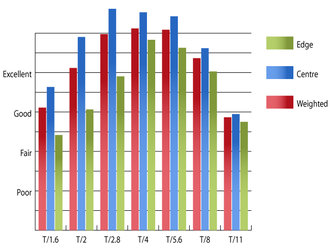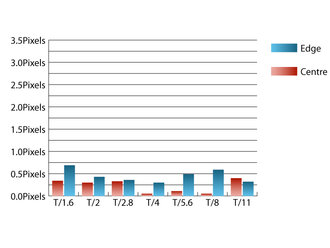SLR Magic 12mm T/1.6 Hyperprime Cine Lens Review
SLR Magic 12mm T/1.6 Hyperprime Cine Performance
Although this lens is sold more for the effect it produces, rather than the performance it delivers, it still performs well for a lens with such a bright maximum aperture. At T/1.6 sharpness in the centre of the frame is already very good, although the clarity towards the edges of the frame just falls short of fairly good levels. Stopping down improves sharpness across the frame and T/4 provides peak performance. Here sharpness is outstanding across the frame.  Resolution @ 12mm | How to read our chartsThe blue column represents readings from the centre of the picture frame at the various apertures and the green is from the edges. Averaging them out gives the red weighted column.The scale on the left side is an indication of actual image resolution. The taller the column, the better the lens performance. Simple. For this review, the lens was tested on a Panasonic Lumix G3 using Imatest. |
Chromatic aberrations are well controlled, keeping well below one pixel width at all apertures. This low level should pose few issues, even in large prints and harsh crops from the edges of the frame.
Falloff of illumination towards the corners is quite well controlled for a wide angle lens with such a fast maximum aperture. At maximum aperture, the corners are 1.92 stops darker than the image centre and illumination is visually uniform by T/5.6.
 Chromatic aberration @ 12mm | How to read our chartsChromatic aberration is the lens' inability to focus on the sensor or film all colours of visible light at the same point. Severe chromatic aberration gives a noticeable fringing or a halo effect around sharp edges within the picture. It can be cured in software.Apochromatic lenses have special lens elements aspheric, extra-low dispersion etc. to minimize the problem, hence they usually cost more. For this review, the lens was tested on a Panasonic Lumix G3 using Imatest. |
Imatest detected 2.5% barrel distortion, which is quite low for a wide angle lens with a fast maximum aperture. Unfortunately there is a slight wave to the distortion pattern, which may make applying corrections in image editing software afterwards a bit of a pain.
In the same way that this lens handles like a lens from a bygone era, it also provides a similar look as far as contrast and flare is concerned. Shooting into the light results in a noticeable loss of contrast and flare can be quite common. However, the look of images taken in light that may cause these effects can be quite endearing, but this lens may not be for you if this kind of look isn't your thing.
Add your message
Login required
Please login here or if you've not registered, you can register here. Registering is safe, quick and free.
Please login here or if you've not registered, you can register here. Registering is safe, quick and free.
photodo Stats
1102 lenses
428 MTF tests
74 in-depth photodo reviews
100+ users join each day
Help the lens community by reviewing or rating a lens today via our lens search
428 MTF tests
74 in-depth photodo reviews
100+ users join each day
Help the lens community by reviewing or rating a lens today via our lens search
Latest Lens Reviews
- Chinon 28mm f/2.8 Vintage Lens Review
- Canon EF 70-200mm f/4L IS II USM Lens Review
- Samyang AF 85mm f/1.4 EF Review
- Sigma 70mm f/2.8 DG Macro Art Review
- Samyang AF 24mm f/2.8 FE Review
- Meike 50mm f/1.7 Review
- Tamron 70-210mm f/4 Di VC USD Review
- Lensbaby Burnside 35mm f/2.8 Review
- Asahi Super Takumar 50mm f/1.4 Review
- Asahi Super-Multi-Coated Takumar 135mm f/3.5 Review
